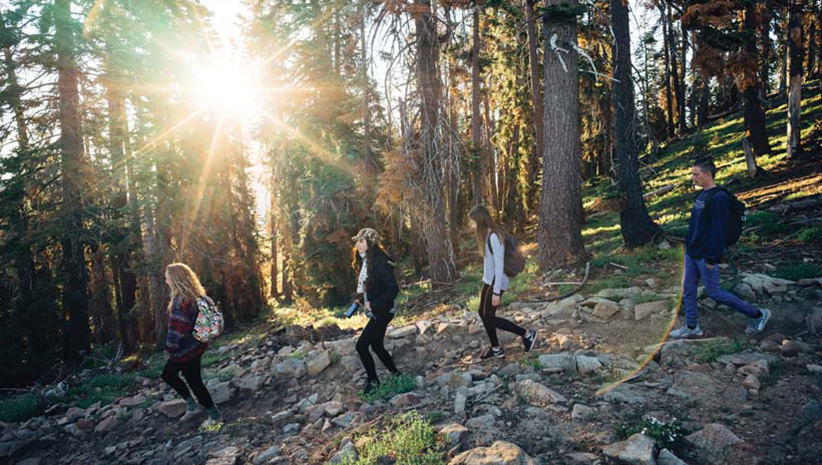
For as long as I can remember, the forest has been a place of healing for me. As a child I would gravitate to the woods for hours. As an adult in this modern multi-tasking world, it has been harder to keep up the habit regularly. I mean, really – if you go outside, you should be exercising and checking your watch to hit that magic number of 10,000 steps. Right?
And into the forest I go, to lose my mind and find my soul.
—John Muir
Wrong. Finally, I have discovered some real science about the positive effects of being in the woods – the practice known in Japanese as Shinrin-Yoku; (English translation, ‘forest bathing.’) In 1982, the Forest Agency of Japan spearheaded Shinrin-Yoku encouraging people to walk outside to reduce stress.
Because of this movement and the subsequent research studies, I now have 21st-century clinical data telling me to go chill out in the woods! As of 2017, more than 127 research papers about Shinrin-Yoku have been published in the scientific literature.
For example, this mindfulness-based method is medically proven to reduce blood pressure and stress hormone levels, increase the NK cell count in the immune system, and even decrease blood glucose levels in diabetics — just to name a few superlative benefits.
How Shinrin-Yoku Works
Here’s how it works. You’re not hiking, or even walking. Shinrin-Yoku is more like wandering. You walk for two hours and go….maybe a mile? It doesn’t matter. What matters is that you put your phone on airplane mode, and open up all eight of your senses to your surroundings.
(Yeah, eight, did you know that? I didn’t. I’m assuming you can get to five on your own, then there is proprioception, interoception, and the vestibular system. For the purposes of brevity, I have to leave it at that, but I highly recommend you explore on your own.)
So, you spend time ambling in silence and seeing what draws your focus. What kind of focus. Sound? A movement in your peripheral vision? Or if you open up all eight senses to on tree or view – what do you experience?
It’s that same mindful, magical feeling we all seek; that space where the monkey mind falls into the background and you begin to feel, dare I say it? At peace. Inside and out. At one, with it all, dropped away from the trick of duality that our ginormous, ego-driven, prefrontal cortex sometimes plays on us. Then, we can build on that feeling through a myriad of methods; we can store it up so it sustains us long after we’ve left the woods.
Nature is alive, and talking to us. This is not a metaphor.
—Terence McKenna
Discoveries of Shinrin-Yoku
One of my favorite things I discovered about the science of Shinrin-Yoku is the extra benefits of bathing in a coniferous, or evergreen, forests. This explains my compulsion to run up to the Sequoia National Forest whenever I can and hug a Redwood sequoiacum.
The bark of these particular trees contains a compound called phytoncides. While this phytochemical protects the tree bark from insects, it also raises our immune system’s NK or killer cells.
Get this: in one study, subjects stayed in a hotel room for three consecutive nights with Hinoki Cypress oil diffusing in a humidifier. The subjects had remarkably heightened levels of these immune boosting suckers in their systems, even up to seven days later. They also reported whiter teeth and fresher breath. (Not really, I wanted to make sure you were still with me.)
The methods I’ve been using in my practice of forest bathing are based on a book by M. Amos Clifford, A Little Handbook of Shinrin-Yoku. I concur with his underlying premise that our personal and societal healing is a two-way street with our planet.
Shinrin-Yoku: The Takeaway
Mother Earth does take care of us, but we must also take care of her. Forest bathing is not only about taking in the healing effects of our environment, but participating reciprocally in methods such as place tending.
Do you wander around the same places? Engage in this practice of place tending or taking care of the environment by bringing a bag for trash. Collect on the way back, so as to not interfere with the forest bathing experience.
These principles can also work in our urban, everyday lives. While writing this, I am sitting in my back garden and I can hear someone playing the electric guitar…I notice sounds of a soccer game…but also I can hear birds.
Some are close, some far away. I can hear the wind in the trees, and align my breathing with that rhythm. I can look around and see bird feeders, little potted seedlings just starting, a happy cat and dog here, too. All this I offer back to Mother Gaia.
The Earth Has a Soul.
— Carl Jung
Forest Photo by Kyle Wolfe
Julie Devi Hale, MFT, eRYT is a psychotherapist, yoga and meditation teacher who attends to private clients in Los Angeles as well as runs retreats regularly in her home away-from-home; the Sequoia National Forest: juliehale.net
